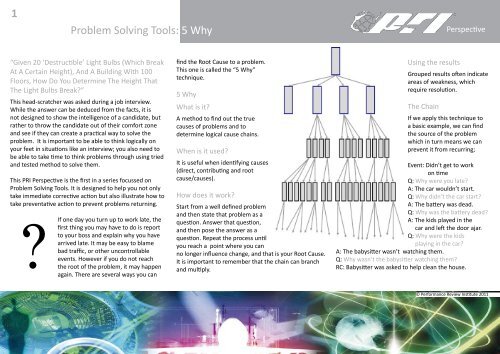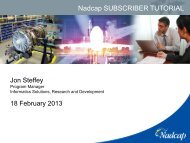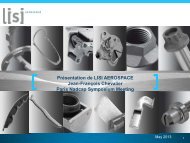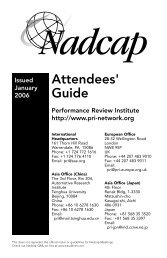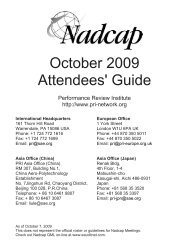Problem Solving Tools: 5 Why 1 - Performance Review Institute
Problem Solving Tools: 5 Why 1 - Performance Review Institute
Problem Solving Tools: 5 Why 1 - Performance Review Institute
Create successful ePaper yourself
Turn your PDF publications into a flip-book with our unique Google optimized e-Paper software.
1<br />
<strong>Problem</strong> <strong>Solving</strong> <strong>Tools</strong>: 5 <strong>Why</strong><br />
Perspective<br />
“Given 20 ‘Destructible’ Light Bulbs (Which Break<br />
At A Certain Height), And A Building With 100<br />
Floors, How Do You Determine The Height That<br />
The Light Bulbs Break”<br />
This head-scratcher was asked during a job interview.<br />
While the answer can be deduced from the facts, it is<br />
not designed to show the intelligence of a candidate, but<br />
rather to throw the candidate out of their comfort zone<br />
and see if they can create a practical way to solve the<br />
problem. It is important to be able to think logically on<br />
your feet in situations like an interview; you also need to<br />
be able to take time to think problems through using tried<br />
and tested method to solve them.<br />
This PRI Perspective is the first in a series focussed on<br />
<strong>Problem</strong> <strong>Solving</strong> <strong>Tools</strong>. It is designed to help you not only<br />
take immediate corrective action but also illustrate how to<br />
take preventative action to prevent problems returning.<br />
<br />
If one day you turn up to work late, the<br />
first thing you may have to do is report<br />
to your boss and explain why you have<br />
arrived late. It may be easy to blame<br />
bad traffic, or other uncontrollable<br />
events. However if you do not reach<br />
the root of the problem, it may happen<br />
again. There are several ways you can<br />
find the Root Cause to a problem.<br />
This one is called the “5 <strong>Why</strong>”<br />
technique.<br />
5 <strong>Why</strong><br />
What is it<br />
A method to find out the true<br />
causes of problems and to<br />
determine logical cause chains.<br />
When is it used<br />
It is useful when identifying causes<br />
(direct, contributing and root<br />
cause/causes).<br />
How does it work<br />
Start from a well defined problem<br />
and then state that problem as a<br />
question. Answer that question,<br />
and then pose the answer as a<br />
question. Repeat the process until<br />
you reach a point where you can<br />
no longer influence change, and that is your Root Cause.<br />
It is important to remember that the chain can branch<br />
and multiply.<br />
Using the results<br />
Grouped results often indicate<br />
areas of weakness, which<br />
require resolution.<br />
The Chain<br />
If we apply this technique to<br />
a basic example, we can find<br />
the source of the problem<br />
which in turn means we can<br />
prevent it from recurring;<br />
Event: Didn’t get to work<br />
on time<br />
Q: <strong>Why</strong> were you late<br />
A: The car wouldn’t start.<br />
Q: <strong>Why</strong> didn’t the car start<br />
A: The battery was dead.<br />
Q: <strong>Why</strong> was the battery dead<br />
A: The kids played in the<br />
car and left the door ajar.<br />
Q: <strong>Why</strong> were the kids<br />
playing in the car<br />
A: The babysitter wasn’t watching them.<br />
Q: <strong>Why</strong> wasn’t the babysitter watching them<br />
RC: Babysitter was asked to help clean the house.<br />
© <strong>Performance</strong> <strong>Review</strong> <strong>Institute</strong> 2011
2<br />
<strong>Problem</strong> <strong>Solving</strong> <strong>Tools</strong>: 5 <strong>Why</strong><br />
Perspective<br />
Test the Chain<br />
Once you have reached what you feel is the Root Cause of<br />
the problem, it is important to test the chain, to check you<br />
have not missed anything. This is easy to do: it is as simple<br />
as climbing back up the chain and asking if the cause<br />
makes the result inevitable.<br />
Root Cause: The babysitter was helping to clean the<br />
house<br />
This caused the kids to play unsupervised<br />
This caused the kids to be able to play in the car and leave<br />
the door ajar<br />
This caused the interior light to be on all night<br />
This caused the battery to die<br />
This caused the car to not start<br />
This caused the event: not getting to work on time<br />
Do I have to ask why 5 times<br />
This is a simple chain of 5 questions which lead to the<br />
Root Cause distracting the babysitter from doing her job;<br />
looking after the children. However the 5 <strong>Why</strong> technique<br />
does not need 5 <strong>Why</strong>s every time; it can be as many or<br />
as few <strong>Why</strong>s as is necessary to find the Root Cause of the<br />
problem.<br />
It may also be that there is more than one chain with<br />
more than one Root Cause. This problem could have<br />
branches breaking off from it at various levels.<br />
Q: <strong>Why</strong> were you late<br />
A: The car wouldn’t start<br />
Q: <strong>Why</strong> didn’t the car start<br />
A: The battery was dead<br />
Q: <strong>Why</strong> was the battery dead<br />
A: The kids played in the car and left the door ajar<br />
Q: <strong>Why</strong> were the kids playing in the car<br />
A: The babysitter wasn’t watching them<br />
Q: <strong>Why</strong> wasn’t the babysitter watching them<br />
RC: Babysitter was asked to help clean the house.<br />
Guidelines for ending your chain<br />
It is important to remember when using this technique<br />
not to go too far in asking <strong>Why</strong>. If you ask <strong>Why</strong> too<br />
many times, this can result in<br />
silly answers. Your answers must<br />
remain within your control and<br />
must be workable. In this example,<br />
we have reached a very workable<br />
Root Cause of the problem of<br />
being late with a simple and<br />
controllable solution: of leaving<br />
the babysitter to do her job.<br />
Q: <strong>Why</strong> didn’t you take a bus<br />
A: I did not know the bus routes<br />
Q: <strong>Why</strong> did you not know the bus routes<br />
RC: I never had a contingency for the car breaking down<br />
A: The battery was old<br />
Q: <strong>Why</strong> was it not replaced<br />
RC: I never get the car battery checked<br />
Conclusion<br />
A Root Cause is the fundamental reason for an event<br />
which, if corrected, would prevent recurrence. There<br />
may be more than one Root Cause to a problem, so it<br />
is important to let the chain lead itself to the final Root<br />
Cause.<br />
And if you are still wondering, you start from the ground<br />
floor and work your way up to the top.<br />
PRI offers professional development opportunities at<br />
convenient regional locations or at your facility.<br />
For additional information and complete training<br />
schedules, visit www.eQuaLearn.com<br />
© <strong>Performance</strong> <strong>Review</strong> <strong>Institute</strong> 2011


